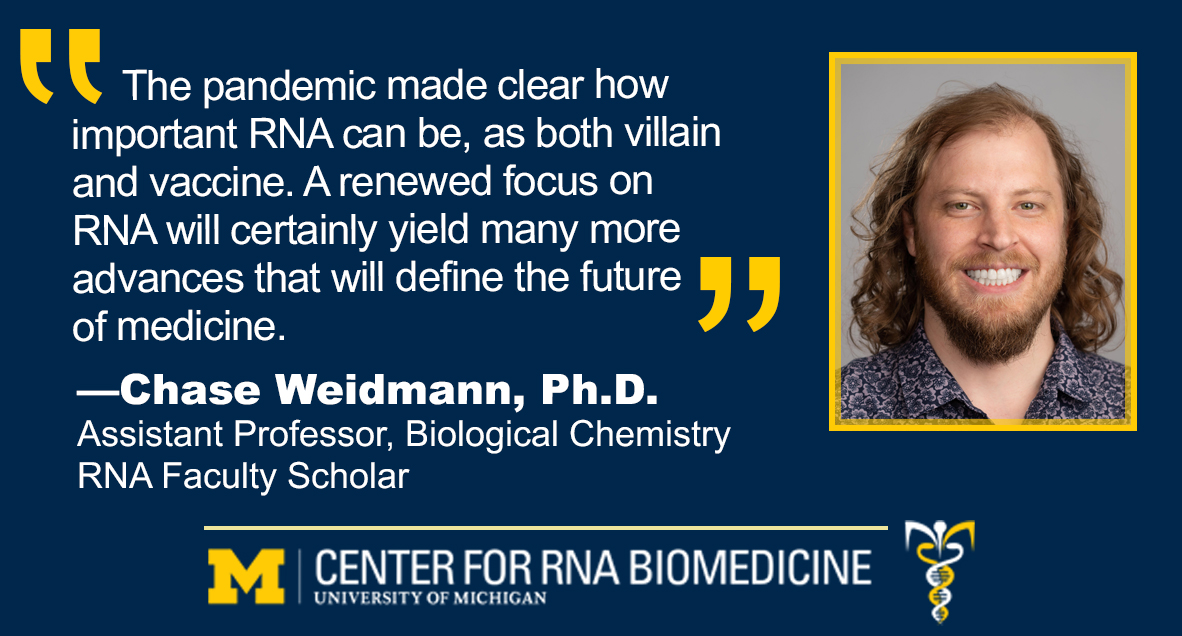RNA Faculty Spotlight – Chase Weidmann, Biological Chemistry
Chase Weidmann, Ph.D.
Assistant Professor
Biological Chemistry, Medical School
RNA Faculty Scholar
Department Website
Google Scholar
We are interested in how cellular signals are propagated through interaction networks at the RNA-protein interface, and how these networks malfunction during cancer and disease. In cancer cells, changes in RNA-binding protein stoichiometry and modification status reorganize the interaction networks of noncoding RNAs, resulting in altered functions. Our vision is to leverage RNA and protein sequencing technologies to characterize these altered interaction network profiles in order to generate novel therapeutic strategies that target the RNA-protein interface.
• What is the role of RNA in your research?
It is the object of study (functional noncoding RNAs), an experimental tool (in reporter assays and genetic screens), and potentially even a therapeutic (antisense or aptamer compounds)
• Is there a layman image/metaphor to explain your research?
Many noncoding RNA complexes are like a set of legos: a modular framework of smaller pieces that can be built into different functional assemblies. If pieces are added haphazardly, the assembly won’t accomplish anything, and, if left in the wrong place on the floor, has the potential to cause serious injury. The pieces in this analogy are RNA-binding proteins, and leaving these haphazardly assembled components in the wrong part of the cell can lead to cancer-promoting changes in DNA expression.
• Who/what brought you to science?
Pretty simply, I fortunately had a continuous streak of engaging science and math teachers throughout middle school and high school. When I thought about a career, I wanted to balance three priorities: 1) the ability to support myself financially, 2) the ability to constantly learn new things, and 3) have a sense of contributing to a greater good. Pursuing a career in science seemed to easily provide that balance, so I sought out a degree in biology/chemistry and discovered a specific interest in RNA in my undergraduate research.
• What brought you to the University of Michigan?
Initially, when I realized I wanted to pursue a PhD, I asked my advisor where I might apply to continue my training, and Michigan was on that list. The combination of great research and great people on display during my interview made it an easy choice. I continued studying RNA biology throughout my dissertation and postdoctoral research. When I saw that Michigan’s new Center for RNA Biomedicine was seeking faculty applicants, I didn’t hesitate to apply to Michigan again.
• What advice would you give to students who’d like to get more involved in research?
Find someone who will let you do research with hands-on support, directly or through their other trainees. Don’t be afraid to go outside of your comfort zone, in the beginning any research experience will teach you something valuable.
• Are there any opportunities for students to engage in your projects, currently or in the future?
My laboratory is only just beginning, but once it is up and running I would be open to those with a desire to learn and contribute, if I felt confident that I could dedicate time to them. For those interested, we’ll be applying a combination of chemical and molecular biology, next-generation DNA and protein sequencing, and bioinformatics analysis to questions of human biology and disease (in cell culture). There is a lot of room for small trial experiments that might form the basis of larger technology development projects, if a trainee is ok with a guided amount of failure.
• What profession other than your own would you enjoy, or what is your favorite hobby?
Sometimes I think I’d be a great Youtube personality. Entertainment media clearly plays a large role in shaping how people perceive a variety of subjects in the real world, including science.
READ about his journey into science
WATCH his introduction video


